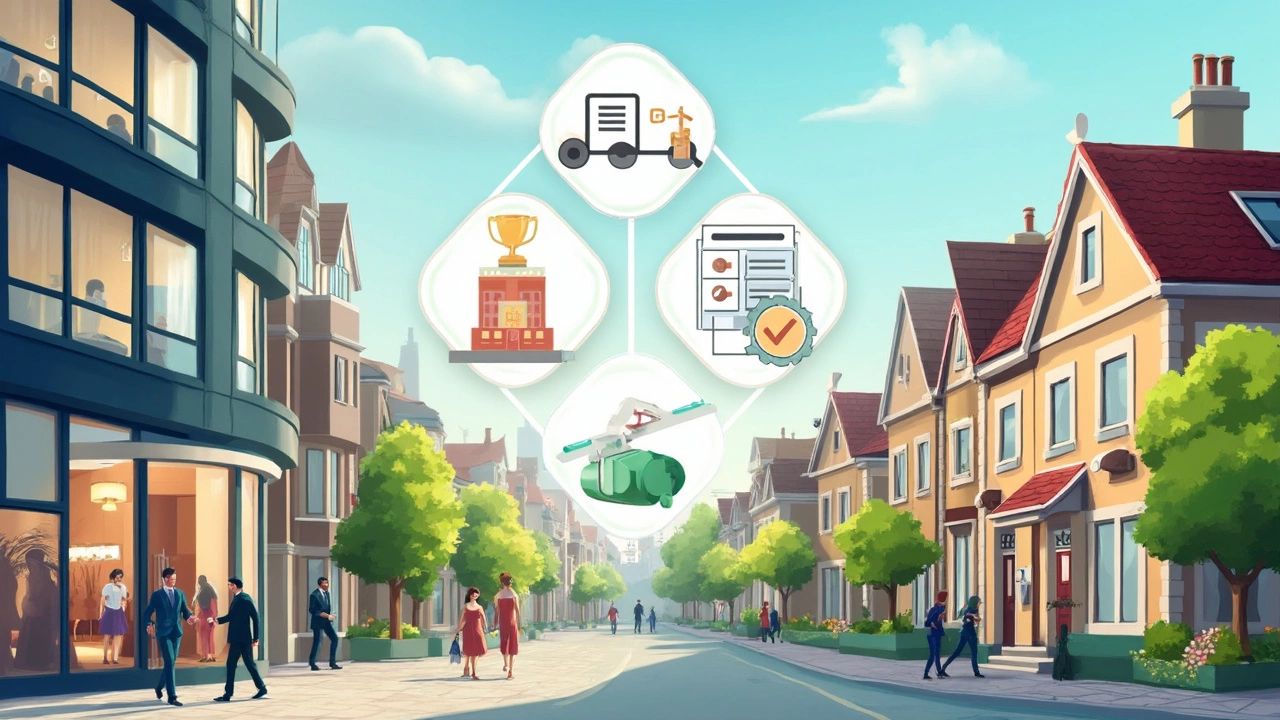Ever thought a building is just a building, no big difference? The reality is, whether you call it commercial or non-commercial can change everything—from the permits you need to the price tag on the whole project.
People often get mixed up, especially when a property works for more than one purpose. For example, is a doctor's office in a home still 'non-commercial'? What about a daycare tucked below an apartment? The answer isn’t always obvious, but knowing which side your project lands on keeps you out of legal hot water, saves you time, and can even impact your insurance rates.
Understanding this split upfront actually speeds things along. You won’t waste time applying for the wrong permits or drawing blueprints that get rejected. If you’re planning to build, remodel, or even just lease out a space, you need to know where you stand.
- Defining Commercial and Non-Commercial in Construction
- Main Purpose and Use Cases
- Regulations and Building Codes
- Common Pitfalls and Surprising Facts
- Tips for Choosing the Right Path
Defining Commercial and Non-Commercial in Construction
First up—what exactly counts as commercial construction, and what doesn’t? It all boils down to how a building will be used. If it’ll host a business, like a store, office, warehouse, hotel, or restaurant, it’s commercial. If it’s mostly homes for people to live in or for personal use—like single-family houses, apartments, or churches—it’s non-commercial. Simple, right? But there are some gray areas worth looking at.
Commercial construction covers buildings that churn out money, pay employees, or serve the public in some way. Non-commercial spaces are usually about private use, not turning a profit. Sounds basic, but there’s more to it when you dig into the rules.
Here’s a quick comparison that clears things up:
| Type | Main Examples | Primary Use |
|---|---|---|
| Commercial | Offices, retail stores, hotels, gas stations, warehouses | Business, sales, public service |
| Non-Commercial | Homes, condos, religious buildings, community centers | Living, worship, non-profit activities |
Sometimes projects cross over. Think about a big apartment building: if it’s got ground-floor businesses, those areas count as commercial, not residential. There’s no one-size-fits-all answer, and local zoning laws can push a project from one category into another fast.
If you’re unsure, check your zoning map and ask the city—no need to guess. When you’re splitting buildings into commercial and non-commercial, always look at what’s happening inside and who’s paying the bills. Getting it right from the start makes a huge difference when you file for permits or talk to lenders.
Main Purpose and Use Cases
If you strip things down, the real split comes from what the building is used for day-in and day-out. That’s what flips the switch between commercial and non-commercial—nothing more, nothing less.
Commercial construction covers any project meant to make money or support business operations. If money changes hands between customers and owners—like in restaurants, stores, hotels, or office spaces—you’re in commercial territory. Even a dentist’s office counts, because patients pay for a service. On the flip side, non-commercial (often called residential or institutional) buildings handle stuff like homes, schools, churches, or community centers where business isn’t the main goal.
"A commercial building generally refers to any structure that’s used to conduct business, whereas non-commercial buildings are largely intended for personal, not-for-profit, or community uses." — National Association of Home Builders
Here’s a quick look at common examples that fall on each side:
- Commercial: Offices, warehouses, retail stores, restaurants, malls, hotels, gas stations, movie theaters.
- Non-Commercial: Single-family homes, apartment complexes, schools, religious centers, government buildings (think post offices, fire stations), non-profit clinics.
The impact of this difference shows up everywhere—from taxes to insurance to what you’re even allowed to build on a lot. For example, the International Code Council says around 31% of construction spending in the U.S. is for commercial projects, showing just how common these builds are. Here’s a quick data snapshot for context:
| Type | Typical Use | % of US Construction Spending (2024) |
|---|---|---|
| Commercial | Business & Services | 31% |
| Non-Commercial | Personal & Community | 69% |
Knowing this up front helps everyone involved set the right expectations, dodge zoning headaches, and land on a project with no bad surprises down the line.

Regulations and Building Codes
This is where things really get serious in commercial construction. Building a business or office isn’t like putting up a backyard shed or a private barn. There are way more rules, and they’re enforced by local, state, and federal agencies. Missing a step can mean big delays or even shutting down your project.
Every city sets minimum codes for construction, but commercial projects take things up a notch. Here’s what you can count on with commercial builds:
- ADA requirements: If your building is public-facing, it’s got to be accessible to everyone. We’re talking ramps, elevators, bathrooms—if it doesn’t meet ADA standards, you’re getting denied permits fast.
- Fire safety rules: The fire code for commercial buildings is strict. Think sprinkler systems, fire exits, alarms, and wider hallways. For example, New York City requires two exit routes for nearly all workplaces, regardless of size.
- Structural integrity: Commercial buildings often need stronger supports since they might serve more people. This means stricter inspections, often during each phase of construction.
- HVAC and plumbing: Not only does it need to work, it also has to be able to handle bigger loads and pass inspections for air quality and energy efficiency.
Non-commercial projects, especially single-family homes, get some leeway here. You’ll still need permits and inspections, but the requirements are less demanding. Many towns let residential builders use wood framing or simpler electrical standards. You still need to play by the rules, but the hoops aren’t as high.
One surprising catch? Mixed-use properties—think apartments with shops below—have to satisfy both sets of rules at once, which can be a real headache. If you’re planning something like this, it’s smart to check in early with the county permit office and a local architect to steer clear of expensive surprises.
Common Pitfalls and Surprising Facts
If you think figuring out whether a project is commercial or non-commercial is just paperwork, think again. Over the years, a lot of contractors and owners have hit stumbling blocks, just because they misunderstood this basic split. One of the biggest trip-ups? Getting the wrong permits. Town halls deny loads of projects every year because folks apply under the wrong category.
There's also zoning rules that can catch you off guard. Some cities slap hefty fines if you run a commercial business in a non-commercial area—even if you just have a few clients dropping by your home office. It's not uncommon to see someone invest thousands into a small fix-it shop out of their garage, only to be shut down in months because the property wasn't zoned for it.
Another weird surprise: insurance. Your policy and rate can jump hugely between commercial and non-commercial buildings. For example, commercial buildings typically pay about 25% more for property coverage compared to similar-sized non-commercial structures, because of the higher risks involved. Here’s a quick glance at common differences that trip people up:
| Category | Commercial | Non-Commercial |
|---|---|---|
| Permit Approval | Longer, more inspections | Shorter, fewer steps |
| Zoning Restrictions | Stricter, can limit use | More flexible |
| Insurance Cost (avg.) | Higher by ~25% | Lower |
| ADA Rules | Usually required | Rarely apply |
One especially tricky area is mixed-use buildings—spaces with shops at street level and apartments above. These almost always get treated as commercial, even if 90% of the building is residential. Many folks are surprised by requirements like extra fire exits or handicap-accessible bathrooms just because there’s a store involved.
Want to steer clear of headaches? Always triple-check your city’s building codes and commercial construction zoning rules at the start. If you’re hiring out, make sure your contractor actually knows the difference—because if they botch it, it’s usually you paying for the fix.

Tips for Choosing the Right Path
The line between commercial and non-commercial construction isn't just paperwork—it's a decision that affects your entire project. Here’s how to make sure you pick the right lane from the start.
- Commercial construction usually requires stricter inspections, more expensive permits, and often higher insurance. Make sure you’re not underestimating costs.
- Check local zoning laws first. Your city might use the term "mixed-use" or have sneaky restrictions for businesses run out of homes. Don’t assume things are allowed just because a neighbor’s doing it.
- Set up a quick call or meeting with your local building department before you lock anything in. Bring plans, ask about requirements, and get names. Decision-makers change, but a paper trail helps you later.
- Talk to your insurance agent about liability. For example, commercial policies can cost three to five times more than home insurance for a similar square footage.
- If you’re financing, remember that banks need clear categories. A lot of lenders won’t touch gray-area projects, so ask up front about their loan criteria.
Here’s a snapshot of common differences in costs and paperwork:
| Factor | Commercial | Non-Commercial |
|---|---|---|
| Average Permit Cost (US) | $5,000 - $25,000+ | $500 - $3,000 |
| Inspection Frequency | Every major phase (often 5+) | Usually at foundation & final |
| Insurance (per $1M coverage) | $2,500 - $10,000/year | $300 - $1,500/year |
| Accessibility Requirements | Strict ADA compliance | Rarely required |
The biggest mess-ups usually come from guessing instead of checking. A fast conversation with officials and lenders beats a year of rework and extra fees. Figure out early if your project fits a commercial mold or if you can keep things simple and stick with non-commercial regulations. Your wallet will thank you.
